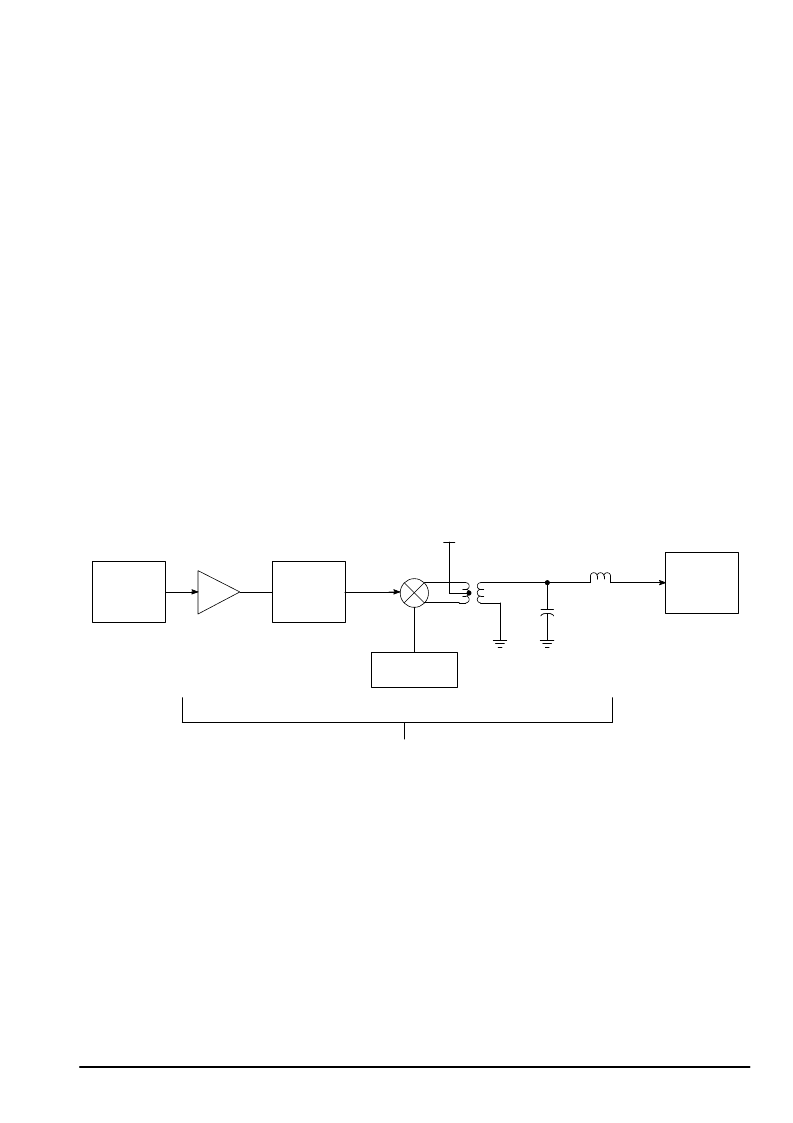- 您現(xiàn)在的位置:買賣IC網(wǎng) > PDF目錄371008 > MC13142 (Motorola, Inc.) LOW POWER DC - 1.8 GHz LNA, MIXER and VCO PDF資料下載
參數(shù)資料
| 型號: | MC13142 |
| 廠商: | Motorola, Inc. |
| 英文描述: | LOW POWER DC - 1.8 GHz LNA, MIXER and VCO |
| 中文描述: | 小功率直流- 1.8 GHz的低噪聲放大器,混頻器和VCO |
| 文件頁數(shù): | 8/16頁 |
| 文件大小: | 176K |
| 代理商: | MC13142 |

MC13142
8
MOTOROLA RF/IF DEVICE DATA
Input Matching/Components
It is desirable to use a RF ceramic or SAW filter before the
mixer to provide image frequency rejection. The filter is
selected based on cost, size and performance tradeoffs.
Typical RF filters have 3.0 to 5.0 dB insertion loss. The PC
board layout accommodates both ceramic and SAW RF
filters which are offered by various suppliers such as
Siemens, Toko and Murata.
Interface matching between the LNA, RF filter and the
mixer will be required. The interface matching networks
shown in the application circuit are designed for 50
interfaces.
In the application circuit, the LNA is conjugately matched
to 50
input and output for 3.0 to 5.0 Vdc VCC. 17 dB gain
and 1.8 dB noise figure is typical at 926 MHz. The mixer
measures 0 dB gain and 12 dB noise figure as shown in the
application circuit. Typical insertion loss of the Toko ceramic
filter is 3.0 dB. Thus, the overall gain of the frontend receiver
is 14 dB with a 3.3 dB noise figure.
System Noise Considerations
The block diagram shows the cascaded noise stages of
the MC13142 in the frontend receiver subsystem; it
represents the application circuit. In the cascaded noise
analysis the system noise equation is:
Fsystem = F1 + [(F2 –1)/G1] + [(F3–1)]/[(G1)(G2)]
where:
F1 = the Noise Factor of the MC13142 LNA
G1 = the Gain of the LNA
F2 = the Noise factor of the RF Ceramic Filter
G2 = the Gain of the Ceramic Filter
F3 = the Noise factor of the Mixer
Note
: the above terms are defined as linear relationships and
are related to the log form for gain and noise figure by the
following:
F = Log –1 [(NF in dB)/10] and similarly
G = Log –1 [(Gain in dB)/10].
Calculating in terms of gain and noise factor yields the
following:
F1 = 1.51; G1 = 50.11
F2 = 1.99; G2 = 0.5
F3 = 15.85
Thus, substituting in the equation for system noise factor:
Fsystem = 2.12; NFsystem = 3.3 dB
Figure 3. Frontend Subsystem Block Diagram for Noise Analysis
fLO = 975.55 MHz
Noise Source
IF Output
Toko Ceramic
Filter
NF Meter
330 nH
VCC
Mixer
Local Oscillator
G1 = 17 dB
NF1 = 1.8 dB
36 p
fIF = 49.05 MHz
Z Transformer
16:1
G2 = –3.0 dB
NF2 = 3.0 dB
LNA
G3 = 0 dB
NF3 = 12 dB
Gsys = 14 dB
NFsys = 3.3 dB
fRF = 926.5 MHz
相關(guān)PDF資料 |
PDF描述 |
|---|---|
| MC13143D | ULTRA LOW POWER DC - 2.4 GHz LINEAR MIXER |
| MC13143 | ULTRA LOW POWER DC - 2.4 GHz LINEAR MIXER |
| MC13144D | VHF - 2.0 GHz LOW NOISE AMPLIFIER WITH PROGRAMMABLE BIAS |
| MC13144 | VHF - 2.0 GHz LOW NOISE AMPLIFIER WITH PROGRAMMABLE BIAS |
| MC13145FTA | UHF WIDEBAND RECEIVER SUBSYSTEM (LNA, Mixer, VCO, Prescalar, IF Subsystem, Coilless Detector) |
相關(guān)代理商/技術(shù)參數(shù) |
參數(shù)描述 |
|---|---|
| MC13142D | 制造商:MOTOROLA 制造商全稱:Motorola, Inc 功能描述:LOW POWER DC - 1.8 GHz LNA, MIXER and VCO |
| MC13143 | 制造商:MOTOROLA 制造商全稱:Motorola, Inc 功能描述:ULTRA LOW POWER DC - 2.4 GHz LINEAR MIXER |
| MC13143D | 制造商:MOTOROLA 制造商全稱:Motorola, Inc 功能描述:ULTRA LOW POWER DC - 2.4 GHz LINEAR MIXER |
| MC13144 | 制造商:MOTOROLA 制造商全稱:Motorola, Inc 功能描述:VHF - 2.0 GHz LOW NOISE AMPLIFIER WITH PROGRAMMABLE BIAS |
| MC13144D | 制造商:MOTOROLA 制造商全稱:Motorola, Inc 功能描述:VHF - 2.0 GHz LOW NOISE AMPLIFIER WITH PROGRAMMABLE BIAS |
發(fā)布緊急采購,3分鐘左右您將得到回復(fù)。